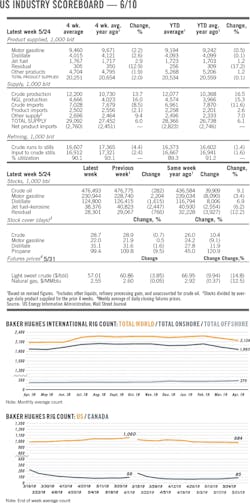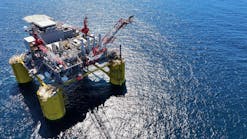GENERAL INTERESTQuick Takes
Ithaca Energy to acquire CNSL in $2-billion deal
Ithaca Energy Ltd., a subsidiary of Delek Group Ltd., will acquire Chevron North Sea Ltd. (CNSL) for $2 billion, adding 10 producing field interests to Ithaca’s existing portfolio, four of which relate to assets operated by Ithaca.
After the transaction, Ithaca’s asset base is estimated to consist of 2P reserves of 225 million boe plus a further 45 million boe of proven and probable contingent (2C) resources associated primarily with additional near-field development and infill drilling opportunities.
Some 500 employees will transfer to Ithaca—200 of which work offshore on the operated assets.
Producing field interest to be acquired are as follows: Captain oil field, 85%; Alba oil field, 23.3%; Erskine gas-condensate field, 50%; Alder gas-condensate field, 73.68%; Britannia gas-condensate field, 32.38%; Brodger gas-condensate field, 6.25%; Callanish oil field, 16.5%; Enochdhu oil field, 50%; Elgin-Franklin gas-condensate fields, 3.9%; and Jade gas-condensate field, 19.93%.
Following completion of the transaction, expected in this year’s third quarter after approval by the UK Oil and Gas Authority, Chevron will provide security and remain financially responsible for the decommissioning obligations of CNSL in respect to interests in Heather and Strathspey fields and the Cambo exploration well.
UK seeks faster offshore issue settlement
UK regulators will increase pressure on offshore operators and equipment owners to settle issues impeding progress toward the government’s goals of maximizing economic recovery (MER). In a June 4 letter to license holders and infrastructure owners, Oil and Gas Authority Director of Regulation Tom Wheeler said OGA “will be more progressively more proactive in using [its] powers.”
Noting that the government’s MER strategy “is binding on all operators, licensees, and infrastructure owners” working off the UK, Wheeler said, “We have seen and still see a number of examples of behavior that threaten MER UK or that otherwise indicate a lack of awareness of the obligations imposed by the MER UK strategy.”
OGA’s concerns are dispute resolutions, issues of third-party access to infrastructure, and anything else threatening MER.
Since 2017, the authority has intervened in 56 cases in a process it calls “measured escalation.” Of those, 14 were closed at the “facilitation” stage and 21 at the “enhanced facilitation” stage. Other cases went to regulatory escalation: 16 to enquiry and 5 to investigation, OGA’s highest level of intervention.
Wheeler said OGA now will:
• Use newly published “enquiry guidance,” which provides flexibility to the use of powers and includes alternative dispute resolution.
• Accelerate movement of issues through measured escalation.
• Increase transparency around its use of regulatory powers and use “thematic reviews” where appropriate.
• Refresh stewardship expectations, including a new one on commercial behavior, and publish a regulatory requirement, which it describes as “consents and authorizations and basic license management.”
APLNG okay to buy Ironbark CSG project
The Origin Energy Ltd.-operated Australia Pacific LNG group has obtained permission to acquire Origin’s undeveloped Ironbark coal seam gas project in permit ATP 788P in Queensland.
The Australian Competition and Consumer Commission said it would not oppose the transaction, first mooted by Origin in February with a sale price of $231 million (Aus.).
Ironbark, not to be confused with the BP PLC-operated Ironbark prospect offshore Western Australia, contains an estimated 134 petajoules of 2P gas resource in the Surat basin.
Origin CEO Frank Calabria said Origin would derive value from the development of Ironbark through its interest in APLNG, which runs a two-train CSG-LNG facility on Curtis Island near Gladstone on Queensland’s central east coast.
The company had previously rejected the options of selling the Ironbark project to a third party or developing the CSG prospect itself. Calabria said neither of these alternatives would have led to a drastically different outcome for east coast gas users from that of the sale of Ironbark to APLNG which already has pipelines in Queensland feeding the Curtis Island plant.
Origin can now process the gas through the plant without the need to negotiate a tolling arrangement with its venture partners. Origin bought a 100% interest in the Ironbark permit for $660 million (Aus.) from Pangaea Group in August 2009.
Spur Energy, KKR buy Percussion’s Permian assets
Spur Energy Partners LLC, Houston, and investment firm KKR have partnered to acquire oil and gas production and development assets across the Lower 48, beginning with a signed agreement to acquire the Permian Northwest Shelf assets of Percussion Petroleum LLC, Houston.
The acquisition includes interests in 380 gross producing wells and 22,000 net acres in the Yeso formation in Eddy and Lea counties in New Mexico as well as associated water and midstream assets. In this year’s first quarter, the assets produced 9,200 net boe/d (85% liquids). Subject to closing conditions, the deal is expected to close in this year’s second quarter.
Spur is led by Chief Executive Officer Jay Graham, co-founder and former chief executive officer of WildHorse Resource Development Corp.
NMFS proposes IHA for Hilcorp project in Alaska
The National Marine and Fisheries Service proposed authorizing incidental harassment approval (IHA) of marine mammals on May 28 during construction and operation of Hilcorp’s proposed Liberty Drilling and Production Island in Alaska. The proposed rule would establish a framework under the Marine Mammal Protection Act for 5 years. Comments will be accepted through June 28.
Hilcorp Alaska, a subsidiary of the Houston-based privately held oil and gas independent, would be required to implement measures which include:
• Use of a soft start during impact pile driving to allow marine mammals the opportunity to leave the area prior to beginning impact pile driving at full power.
• Shutting down construction activities under certain circumstances to minimize harassment, including injury.
• Prohibition of impact pile driving during the fall Cross Island bowhead whale hunt and seasonal drilling restrictions to minimize impacts to marine mammals and subsistence users.
• Implementing best management practices to avoid and minimize ice seal and habitat disturbance during ice road construction, maintenance, and use.
• Use of marine mammal and acoustic monitoring to detect marine mammals and verify predicted sound fields.
• Limiting vessel speeds and transit areas, where appropriate.
National Ocean Industries Association Pres. Randall B. Luthi welcomed the proposal. “There are more than 230 active IHAs covering military exercises, oil and gas exploration and development, renewable energy development, scientific research and construction projects,” he said.
Luthi said the proposed incidental take authorizations for Hilcorp’s Liberty project include provisions that firmly restrict operations and require impact monitoring, assuring little or no effect on marine mammals in the project area.
EPA issues draft study on wastewater management
The US Environmental Protection Agency issued a draft study on how the agency, states, Indian tribes, and other stakeholders manage wastewater from onshore oil and gas extraction. The undertaking will leverage expertise from those groups to identify challenges and opportunities surrounding the potential benefits of reusing the wastewater, said David Ross, EPA Office of Water assistant administrator.
The agency originally initiated the study in May 2018 and held several meetings with affected groups, and accepted comments online at www.regulations.gov. It took additional comments at its headquarters last year where officials said they hoped to produce a white paper on the subject early in 2019 but acknowledged that it would be difficult.
Many entities expressed support for increasing opportunities for discharge of oil and gas extraction wastewater to surface waters, especially where these wastewaters could address critical water resource needs, EPA said. Some entities expressed concern that discharges to surface waters could have adverse environmental impacts, it added.
It said it would accept comments on the draft study until July 1. Interested parties may email their input to [email protected]. After considering the feedback it receives, the agency will finalize the study later this summer. EPA will determine at that time what, if any, future agency actions are appropriate to encourage the beneficial reuse of oil and gas extraction wastewater under the Clean Water Act. This could include both regulatory and nonregulatory approaches, it said.
Second Total solar plant in Japan starts
Total SA has started commercial operation of its second solar power plant in Japan, a 25-Mw unit at Miyako on Honshu Island. The facility, owned 50-50 by Total Solar and Chubu Electric Power Co. Inc., uses nearly 77,000 solar panels manufactured by Total affiliate SunPower.
In partnership with ISE Group and SunPower, Total started up the 27-Mw Nanao solar power plant at Ishikawa in April 2017.
Exploration & DevelopmentQuick Takes
Sierra Leone reopens fourth licensing round
The Petroleum Directorate of Sierra Leone, in partnership with GeoPartners Ltd. and Getech Group PLC, announced the reopening of the fourth licensing round for offshore areas reaching from near short to ultradeep water.
The round was reopened after a 6-month industry consultation with industry. An initial fourth round was put on hold in September 2018.
“Having completed its consultation, the Petroleum Directorate has put in place a robust but flexible licensing framework that will assist investors,” said Getech CEO Jonathan Copus.
No details were immediately available regarding the changes made for the reopening. Eight wells have been drilled offshore Sierra Leone since 1982, round organizers said.
Anadarko Petroleum Corp. had three discoveries of natural gas and light oil (OGJ Online, Feb. 21, 2012). Lukoil reported a light oil discovery in 2013 on the Savannah structure although few details were made available (OGJ Online, Sept. 13, 2013).
Novatek acquires five Krasnoyarsk licenses
Units of Novatek have acquired exploratory licenses for five areas on the Gydan Peninsula in Krasnoyarsk, Russia.
Novatek-Yurkharovneftegas bought geological survey licenses for the Khalmeryahskiy, Dorofeevskiy, and West Dorofeevskiy areas. Novatek-Tarkosaleneftegas received geological survey licenses for the South Khalmeryahskiy and South Dorofeevskiy areas. The areas are near existing Novatek license areas.
Eni farms in to blocks offshore Mozambique
An Eni SPA subsidiary has farmed in to three blocks offshore Mozambique in an agreement with ExxonMobil Mozambique Exploration & Production Ltd., the operator.
The Italian company acquires 10% interests in:
• Unexplored Block A5-B, covering 6,080 sq km in 1,800-2,500 m of water about 1,300 km northeast of Maputo.
• Lightly explored Blocks Z5-C and Z5D, covering a total of 10,205 sq km in 500-2,100 m of water facing the delta of the Zambezi River about 800 km northeast of Maputo.
Remaining interests are ExxonMobil, 40%; state-owned Empresa Nacional de Hidrocarbonetos and Rosneft, 20% each; and Qatar Petroleum, 10%.
Drilling & ProductionQuick Takes
Equinor to make FID on Rosebank offshore UK
Equinor said it would make a final investment decision by May 2022 on Rosebank, which it plans to develop using a floating production, storage, and offloading vessel.
Last year, Equinor finalized an agreement to acquire Chevron Corp.’s 40% operated interest in the Rosebank project, one of the largest undeveloped fields on the UK Continental Shelf.
Rosebank field is 130 km northwest of the Shetland Islands in 1,110 m of water. It was discovered in 2004. Other field partners are Suncor Energy Inc. 40% and Siccar Point Energy 20%.
Equinor has said the transaction will strengthen its UK assets, which includes the Mariner development, exploration opportunities, and three producing offshore wind farms.
TransGlobe Egyptian strike due on stream
TransGlobe Energy Corp., Calgary, plans to bring its South Ghazalat (SGZ)-6X discovery in Egypt’s Western Desert on production at an initial rate of 1,000 b/d of 34° gravity crude oil in this year’s fourth quarter under a newly approved develop lease (OGJ Online, Nov. 19, 2018).
The company will use initial production from the Late Cretaceous Upper Bahariya formation to assess reservoir performance. It plans to truck oil 15 km to a connection with a pipeline to the El Hamra Terminal on the Mediterranean.
TransGlobe, which holds a 100% working interest in the lease, plans to drill an appraisal well in the third or fourth quarter, subject to rig availability. Production from the appraisal well could be tied in to an early production facility to be built for the SGZ-6X well.
The company also is merging and reprocessing two 3D seismic surveys over the 7,340-acre development area to identify targets for future exploration and appraisal drilling.
In Egypt’s Eastern Desert, meanwhile, TransGlobe expects to start production in June from two development wells on the productive West Bakr block, in which it acquired a 100% working interest in 2011 (OGJ Online, Mar 28, 2011).
Drilled to 4,741 ft, the K-63 well recently encountered an estimated 74 ft of net oil pay in the Miocene Asl A formation, based on logs and samples. It will be brought on production with the earlier drilled H-30 development well, which encountered an estimated 25 ft of net oil pay. The HW-2X discovery well on the West Bakr concession, with an estimated 113 ft of net oil pay, is producing about 700 b/d.
TransGlobe will move the rig to the Northwest Gharib production-sharing contract area to drill the NWG 38D-1 exploration well targeting a fault block next to the producing 38A pool.
CNRL agrees to buy Devon’s Canadian assets
Canadian Natural Resources Ltd. (CNRL) will increase its oil production capacity by 128,300 b/d before royalties with the purchase of Devon Canada Corp. for $3.775 billion (Can.) cash. Devon Energy Corp. announced early this year its plan to shed Canadian operations and natural gas production to focus on US oil (OGJ Online, Feb. 20, 2019).
The companies have agreed to CNRL’s acquisition of thermal in situ properties that the acquiring company estimates are able to produce 108,200 b/d of crude oil from 701 million bbl of proved reserves, all operated, and conventional properties able to produce 20,100 b/d from 29 million bbl of reserves, 95% operated. The deal is subject to regulatory approvals.
It includes 1.5 million acres of land, of which a total of 1 million acres is undeveloped.
At closure, CNRL will have thermal in situ production capacity of about 320,000 b/d.
It projects yearend production of 250,000 b/d from thermal in situ properties, 450,000 b/d from oil sands mining and upgrading, 150,000 b/d of conventional light crude and NGL, 120,000 b/d of heavy crude oil, and 220,000 boe/d of gas.
Devon Canada has 735 employees.
Equinor granted North Sea drilling permit
Equinor Energy AS has been granted a drilling permit by the Norwegian Petroleum Directorate for well 16/5-7 in production license 502 in the North Sea.
The well will be drilled about 3 km west of the southern part of Johan Sverdrup field using Transocean Ltd.’s Transocean Spitsbergen harsh-environment, ultradeepwater, dual-activity, semisubmersible drilling rig.
This is the second exploration well to be drilled in PL 502. The area in PL 502 consists of a part of Block 16/5.
Equinor serves as operator with 44.44%. Other partners are Petoro AS 33.33% and Aker BP AS 22.22%.
PROCESSINGQuick Takes
Altus commissions Alpine High gas processing train
Altus Midstream Co., a jointly owned partnership of Apache Corp. and Kayne Anderson Acquisition Corp., has commissioned the first of its three cryogenic natural gas processing trains at its Diamond Cryo Complex (DCC) in Alpine High in the Delaware basin (OGJ Online, Aug. 9, 2018).
With a nameplate capacity of 200 MMcfd, the train is now processing rich gas and delivering NGLs as well as residue gas to sales, Altus Midstream said.
The operator said it expects to start up the DCC’s second processing train in July, with the third train scheduled for commissioning by the end of this year’s fourth quarter.
Once start-up of the second and third trains is completed, DCC will have a combined cryogenic processing capacity of 600 MMcfd and be able to produce an estimated 60,000-75,000 b/d of NGLs for Apache, Altus Midstream’s primary customer.
All three cryogenic trains will feature Honeywell UOP LLC’s supplemental rectification with reflux (SRX) processing technology to optimize processing economics with better NGL recoveries in both ethane recovery and rejection mode vs. more commonly used processing methods in the Permian basin, said Altus Midstream Pres. and CEO Clay Bretches.
“Better recoveries will drive enhanced netbacks for Apache and provide a competitive advantage to Altus for third-party business,” Bretches added.
Petronor begins turnaround at Bilbao refinery
Petroleos del Norte SA (Petronor) has started planned maintenance on the largest of two crude distillation units at its 240,000-b/d refinery at Muskiz near Bilbao, Spain.
The more-than 140,000-b/d Refining Unit 1 was taken offline on May 27 for a scheduled turnaround that will run through the first half of July, Petronor said.
As part of the turnaround, which will require an overall investment of about €49 million, Petronor will spend €27 million on routine maintenance and upgrades, with the remaining €22 million to be allocated to technology improvements.
The main project during the turnaround includes installation of an air preheater in the crude furnace to improve energy efficiency and reduce carbon dioxide emissions at the unit.
During the maintenance period, Petronor said the more-than 100,000-b/d Refining Unit 2 will continue to operate normally at the site, allowing the refinery to guarantee ongoing supplies to its customers.
The last turnaround of Refining Unit 1—which receives crude feedstock from the Port of Bilbao for processing to serve other units of the company—took place in 2013, Petronor confirmed. The operator also completed a €52-million turnaround involving maintenance, upgrades, and technology improvements at the refinery’s conversion unit in January. Petronor is owned by Repsol SA 85.98% and Kutxabank SA 14.02%.
SOCAR, Tefken eye urea plant in Azerbaijan
State Oil Co. of the Azerbaijan Republic (SOCAR) and Tekfen Holding, Istanbul, have signed a memorandum of understanding on construction of a urea production facility at Sumgayit, Azerbaijan. The facility would have capacities of 1,200 tons/day of ammonia and 2,000 tons/day of urea.
TRANSPORTATIONQuick Takes
Court blocks BC anti-Trans Mountain bill
The British Columbia Court of Appeal has ruled against provincial legislation that could have blocked expansion of the federally owned Trans Mountain Pipeline system.
The legislation would have enabled the BC government to require a permit for the handling of heavy oil and thus to disallow the expansion project, which Premier John Horgan strongly opposes. The court ruled unanimously that the legislation exceeds provincial jurisdiction.
The federal government bought the stymied Trans Mountain system and expansion project from Kinder Morgan in May 2018 (OGJ Online, Apr. 18, 2019).
Planned to nearly triple capacity of the 1,150-km system between Alberta and BC to 890,000 b/d, the project would ease a transport bottleneck lowering the value of bitumen in Alberta.
Cameron LNG ships first cargo from Train 1
Cameron LNG LLC has shipped the first commissioning cargo of LNG from Train 1 of its facility in Hackberry, La., said Sempra Energy subsidiary Sempra Energy LNG.
Commissioning cargos are a critical step in the start-up process and support stabilizing production and performance testing, the company said. Commercial operations are expected midyear following authorization from the US Federal Energy Regulatory Commission.
Once fully operational, Train 1 will have the capacity to produce 4 million tonnes/year of LNG. The overall project includes three liquefaction trains with a projected export of 12 million tpy (1.7 bcfd) of LNG. An expansion, if undertaken, would include two additional liquefaction trains and as many as two additional full containment LNG storage tanks. The expansion is capable of increasing LNG production capacity by 9.97 million tpy (1.41 bcfd) of LNG. If constructed, Cameron LNG’s export capacity will be 24.92 million tpy (3.53 bcfd).
Cameron LNG is jointly owned by affiliates of Sempra LNG LLC, Total SA, Mitsui & Co. Ltd., and Japan LNG Investment LLC, a company jointly owned by Mitsubishi Corp. and Nippon Yusen Kabushiki Kaisha.




